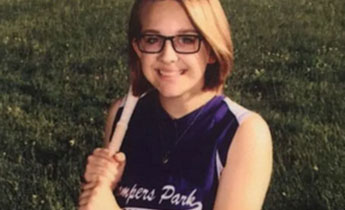Chicago teenager Emma Falk just finished playing her spring high school softball season successfully after putting the game on hold this past fall. She had been recovering from an increasingly common knee injury among athletic girls her age – an anterior cruciate ligament (ACL) tear.
She injured her ACL, which runs through the middle of the knee, as she slid into second base during a park district league game last summer.
“I heard a click and a pop,” Emma describes. “At first I thought I dislocated my knee.”
 Her mother recalls Emma could barely put weight on it. She had to be carried off the field.
Her mother recalls Emma could barely put weight on it. She had to be carried off the field.
After seeing Craig Westin, M.D., orthopedic surgeon at the Chicago Center for Orthopedics at Weiss Memorial Hospital, and undergoing an X-ray and magnetic resonance imaging (MRI) test, Dr. Westin confirmed the ACL tear diagnosis.
“I heard of ACL injuries, but I never thought it would happen to me,” Emma says.
Her treatment: ACL reconstruction surgery at Weiss Memorial Hospital and months of intense rehabilitation.
The ACL is an essential internal stabilizer of the knee joint, keeping the thigh and shin bones from shifting, and needed for direction-change sports. Once damaged, it has to be replaced to maintain an active lifestyle.
“We rebuilt Emma’s torn ligament,” Dr. Westin says.
ACL Reconstruction Surgery
The minimally-invasive procedure involves removing the damaged ACL and preparing to attached new, healthy tissue. Tunnels are drilled through the bone so graft tissue can be used to reconstruct the ACL and attach it to the thigh bone (femur) and shin bone (tibia). The bone grows around the new ligament in a few weeks and hold it permanently.
Following surgery, Emma says much of the pain she was feeling subsided.
Within two weeks of surgery, the body begins to remodel the graft into the patient’s own tissue.
Six weeks after surgery is when the graft is most vulnerable – remodeling of the tissue is at a peak and its weakest point. “Six weeks after surgery the repaired knee often feels good enough to do the wrong thing,” Dr. Westin warns. He says some patients want to work out aggressively, but he advises against it.
After the first two months, ACL grafts become progressively stronger.
Post-Surgery Rehabilitation
Emma says she worked hard doing her exercises but not too hard. Her mother Karyn Falk adds, “Her physical therapy involved strengthening leg and core muscles – getting her leg in motion and bending the knee. She wants to keep the muscles strong so she doesn’t reinjure herself.”
Emma has played the catcher position, which is hard on knees in a squat stance. “I need strong legs.”
High Incidence of ACL Injuries Among Females
Emma is among a high number of females – young and old – faced with ACL injuries.
According to the American Academy of Orthopaedic Surgeons (AAOS), female athletes are two to 10 times more likely to endure an ACL injury compared to male athletes.i
Experts continue to debate reasons why. Research has identified anatomical, psychological and biological differences between genders for the increased risk of injury.
- Anatomy. Women have wider hips, narrower knees and smaller knee bones compared to men.
- Mind-muscle coordination. Women and men land differently when they jump. Women’s knees more commonly turn inward when landing a jump compared to men.
- Menstrual cycle. Estrogen receptors are found in the ACL. The frequency of ACL injuries in women vary with a woman’s menstrual cycle.
ACL Injury Prevention
Injury prevention should include strengthening the stabilizing muscles of the knee, and the core muscles of the pelvis.
Dr. Westin advises athletes work on the following:
- Land correctly. Learn the safest way to land a jump – with feet spread hip-width apart and knees straight or turned slightly outward.
- Strengthen hip rotator muscles. Hip rotators are protectors, especially muscles that outwardly (externally) rotate the femur. During sports, the external rotators keep the thigh and knee straight and prevent inward twisting of the thigh. Sudden, unexpected inward rotation of the femur on a planted leg is a common cause of ACL tears.
An American Journal of Orthopedics study reveals athletes have a six times greater chance of another ACL injury within two years of their first reconstruction surgery – females are twice as likely to get reinjured than malesii, so protective exercise and training are crucial for them.
Emma’s post-surgery rehabilitation worked to get her back in the game this year. She expects to continue strength training and stay conditioned to prevent future injuries, especially next spring during her last year of high school play.
[i] Hewett, T.E. Why women have an increased risk of ACL injury, AAOS Now, 2010 November. Online version.
[ii] Paterno, M.V., Rauh, M., Schmitt, L.C., Ford, K.R., Hewett, T.E. Incidence of Second Anterior Cruciate Ligament (ACL) Injury 2 Years after Primary ACL Reconstruction and Return to Sport. American Orthopaedic Society for Sports Medicine 2013 Annual Meeting. Am J Orthop. 2013 August; 42(8):347B-348. Online version.
